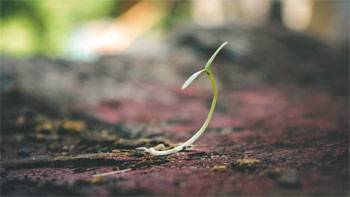Create Your Own Compost to Reduce Waste

International Compost Week
Emilie Porterfield, Co-owner, Pop-Up Gardens shares her expert tips for International Compost week next week.
Emma says: "Home composting is a great method of reducing your family's waste. Even if you only have a small garden or balcony, there are lots of ways you can go about composting."
"Choosing the right compost method for your home is important."
Here are a few of the options:
- For larger gardens or households, a large bin (or even an open compost pile) are a great way to produce large quantities of rich and fertile compost.
- For smaller gardens a compost tumbler is a fantastic option. This is a barrel on a stand, which can literally be spun (or 'tumbled') using a handle, which ensures the compost is mixed evenly, allowing it to break down faster.
- Where outdoor space is very limited a worm farm is great. This is a unit specifically designed to house live worms - you put your scraps in, and the worms help to break them down quickly, creating a liquid compost.
- Even if you have no outdoor space at all, there are great indoor options these days! You can get a bokashi bin, which is designed specifically for indoor use - it uses beneficial bacteria to ferment kitchen waste in 2 - 4 weeks. It is recommended that you have 2 bins, so that you can rotate them - filling one up with new scraps, whilst leaving the full one to ferment. Bokashi bins produce a potent liquid compost which is great for your home-grown veggies.
- There are also community compost schemes, where local residents, community gardens, schools etc take waste donations to add to their compost piles. So even if you don't have the ability to make your own compost bin, you can still reduce your waste and contribute to a local community project. Check out the ShareWaste app to see who in your local area is collecting scraps.
Tips to ensure your garden compost works effectively:
- It's a great idea to have a small compost bin or 'caddy' in your kitchen, for easy disposal, which can then be emptied regularly into a bigger bin outside. Ensure your caddy has air circulation to avoid rot and reduce smells. Cover the air holes with gauze or netting to avoid flies getting into it.
- In your main compost bin, make sure you use a good mixture of green waste and brown waste (ideally 50/50). Green waste is 'wet' waste, which includes vegetable and fruit scraps, grass and plant clippings, coffee grounds & paper filters, tea leaves etc. Brown waste is 'dry' waste, which includes dry leaves, wood chips & sawdust, shredded paper and cardboard, eggshells, nut shells, hair & animal fur etc.
- Avoid adding meat products (off-cuts, fat, bones etc) greasy or oily foods, dairy products, pet waste, or any items which are not fully biodegradable such as face/surface wipes, teabags (which usually contain plastic), and any 'degradable' plastics (because these do not break down fully, they only break into smaller pieces of plastic).
- Make sure your compost gets plenty of air - this is required to create the aerobic reaction which causes the materials to break down into compost. If you're creating your own compost bin, ensure you drill air holes. Stick gauze over the holes.
- When adding lots of green waste to your bin (such a veggie scraps), it's always a good idea to add a thin layer of brown waste over the top. This will reduce flies and will prevent smells escaping.
- It's a great idea to mix or turn the materials regularly whilst they're breaking down. This will help the compost to break down quicker, and will ensure a good distribution of green and brown matter throughout the mix.
- Your compost should be moist but not wet. If it's too wet, add some sawdust or other dry materials. If it looks too dry, add a bit of water and mix it up.
Finished compost should look, feel and smell like a rich dark soil. Once it is fully broken down, you should no longer be able to see any of the separate items which were originally added to the mix. The compost can added to your potting mix when planting, can be sprinkled on your garden beds as a mulch, or can be mixed through the existing soil to improve its condition.
MORE





